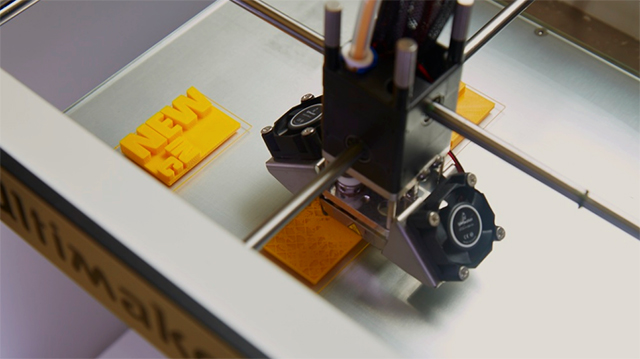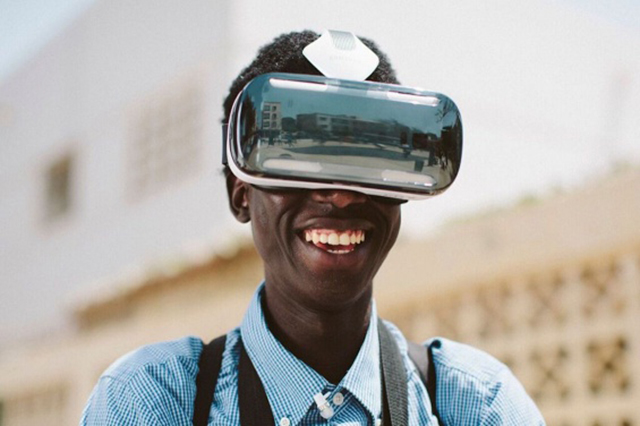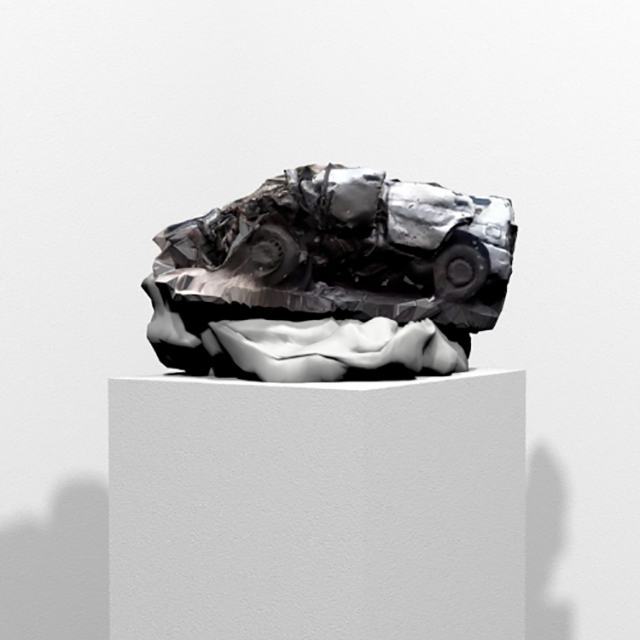
It’s been about 35 years since we were first promised a viable, commercial virtual reality headset. The time for that promise to be fulfilled seems to be upon us with major technology companies going all in on the research and infrastructure that will be necessary to make it happen both as a technology and a product.
NEW INC, the New Museum’s ambitious effort to fuse artist residencies, coworking spaces and business incubators into one singular program, has had two years to become a fully-formed innovation. It’s tough to say whether that’s happened yet, but the latest “Public Beta” (on through July 31st, part 2 will run from August 4-7th) is certainly different than any exhibition going right now and indicates that what’s to come could be a weird and original niche between several disciplinary worlds.
Located next door to the New Museum on Bowery, NEW INC is a non-profit, affordable workspace that handles admissions through a selective application process. Its stated mission is to work with artists and creative people who fall somewhere in between the commercial and gallery worlds without really fitting into either. The showcase itself feels like something between a gallery exhibition and a trade show. To truly assess how NEW INC is doing you’d need to hear from specialists in business, networking, tech and art. Art is our forte, so we’ve highlighted some of the stronger projects that fall in our wheelhouse below.

Still from James Orlando’s Hyper.Zone
Hyper.Zone
Video games have acted as a sort of trojan horse for innovation since the dawn of consumer computing. Remember Solitaire on Windows? Yeah, that was primarily included with the OS to familiarize people with using the drag-and-drop function of a mouse. Likewise, Hearts was intended to get people comfortable with interacting online.
James Orlando’s project Hyper.Zone is attempting to gamify the online gallery space. There have been attempts at creating a viable virtual art gallery going back to at least the beginning of Second Life, but no one has quite pulled it off yet. In recent times, Di Mo Da has made strides in creating a VR space for art and Panther Modern has put together some very pretty exhibitions that are high-res and non-interactive. But no one has cracked the virtual marketplace yet.
The biggest change that Hyper.Zone is introducing is the use of simple game elements that pull you along inside its artificial environments. In one level, you explore a gallery and collect coins, once you’ve collected all the coins a new artwork appears. In another level, you drive a racecar around an installation.
Items for sale include works by Jeanette Hayes and Sigrid Lauren. You will be able to buy real, physical items that will ship to the purchaser or digital only items that can be arranged in a collector’s virtual apartment.
Two problems that this project could address is the age-old issue of art being presented in stale environments. The virtual world is fairly limitless. The other is the sale of performance art. For the Sigrid Lauren piece, Orlando used NYU’s motion capture facilities to record Lauren and upload her performance to an icy cave environment. The idea of using motion-capture makes a lot more sense than video when it comes to documenting performance. With that type of data a viewer could see the performance from any angle or distance.
The biggest hurdle the gaming side of this project will face is whether it’s actually fun. At the moment, things are in the early stages and are just barely on the edge of functioning so I can’t say that anyone will be needing a Hyper.Zone fix the way they might pour time into Candy Crush but the potential is there.
There’s also the question of whether traditional collectors will care. If not, maybe a new type of collector will evolve. Millions of people already drop real cash on virtual costumes in games like World of Warcraft or League of Legends, maybe those people will be the next one’s who are turned on to art.

Still from the documentary, Afripedia. Photo: Stocktown Films
Afripedia – Dance Battle 360°
Less of an innovation than an implementation, this project utilizes affordable 360° filming technologies. The members of Stocktown traveled to Senegal to use this emerging technology to document dance battles on the street.
Afripedia began as a five-part documentary series by Stocktown Films featuring visual artists, filmmakers, fashion designers, musicians, photographers and cultural activists working in South Africa, Angola, Kenya, Ivory Coast, Senegal, and Ghana. Now the filmmakers are extending the project into the virtual reality realm.
Dance Battle 360° utilizes a readily available, and relatively inexpensive GoPro camera rig that makes it easy to document an entire environment. This is the same basic rig that the New York Times is using for its 360° video content. While it’s not always perfectly seamless, the video does have a “you are there” quality that puts you right in the middle of the Dance Battle. Even the people on the sidelines in Senegal wouldn’t have this perspective.
One of the founders, Senay Berhe, told me that the group’s immediate plans are simply to tour the project at film festivals and raise support. But long-term, they hope to continue to travel through the African continent and document cultural happenings–original sources that many are influenced by, but few are able to experience.
This isn’t a flashy project looking to launch a new proprietary technology, it’s just an initiative that needs incubating.

Sculpture from Charles Sainty’s Nothing To See. Photo: New Museum
Nothing to See
Here’s an example of New Inc simply bringing in an artist to work on his art.
Charles Sainty is a multi-disciplinary artist who recently became fascinated with videos he found online of car wreckage. The videos just are rudimentary, hand-held documents of car crashes that he sees as a sort of online version of rubbernecking. Of course, the internet has a way of indulging our worst impulses and these videos dedicate time to really looking over these artifacts of tragedy as opposed to the quick slow down and glance over that a passing motorist would give.
Sainty realized that these videos actually contained the information he needed to convert a series of photos into a 3D object and set about working on “Nothing To See.” For the Public Beta showcase, he has 3D-printed two crashed cars and put together a mock junkyard collection of the models that anyone can explore using an Oculus Rift and a video game controller.
The models are imperfect due to the lack of control he has over the found videos and the unpolished software that used to handle the conversions. They basically look like Clement Valla’s “Postcards From Google Earth” mixed with Jon Chamberlain‘s junkyard crinkles. I mentioned Chamberlain to Sainty and he said that work was certainly on his mind along with Warhol’s Disaster series. He considers “Nothing To See” as part of a history of artistic inquiry into humanity’s morbid fascination with looking at tragedies.

A flirting goblet. Photo: New Museum
The Critical Marketplace
Everything we’ve highlighted above is categorized under the “Virtualities” section of NEW INC’s program. But, there’s a whole other section that is dubbed “The Critical Marketplace” and it is dedicated to projects that have a more commercial nature.
Take Antibot Wear for example, it’s a fashion line created by the group exonemo. Shoppers are invited to use a tablet interface and design a custom print on apparel that ranges from hats to leggings. There a number of pattern options but the primary purpose is for people to print captchas on clothing that would be unreadable by a computer. Aside from the sea-punkish-aesthetic, the group sees this as a tool for freedom of speech in a dystopian future. If someday, we are surveilled and text recognition software identifies messages of dissent, it wouldn’t be readable. Anyways, I don’t think they truly consider this some sort of practical solution, just a comment on surveillance and so it goes with many of the products in The Critical Marketplace section.
Additionally, Antibot Wear is made possible by Print All Over Me, an alumni of NEW INC’s first class. PAOM designed the software that is used for the apparel customization. This is one example of the incubator as networking facilitator.
Some of the products in this section are very practical, like Bhold’s 3D-printed smartphone stands/audio enhancers. Other projects are kind of ridiculous, like “Flirting Goblets” by HE+HU.
Wearing enormous matching banana pins and giant smiles He Wei and Hu Naishu greeted me with infectious energy and thrust a goblet filled with sparkling wine into my hand. The goblet had a feather and motor attached to it and all it did was wave that feather back and forth. They explained that their design practice focuses on increasing communication with food and art. The goblets exist as an icebreaker and a tension diffuser. When everyone looks stupid you start to feel less self-conscious is the idea. Hey, it’s so absurd it just might work.


Comments on this entry are closed.